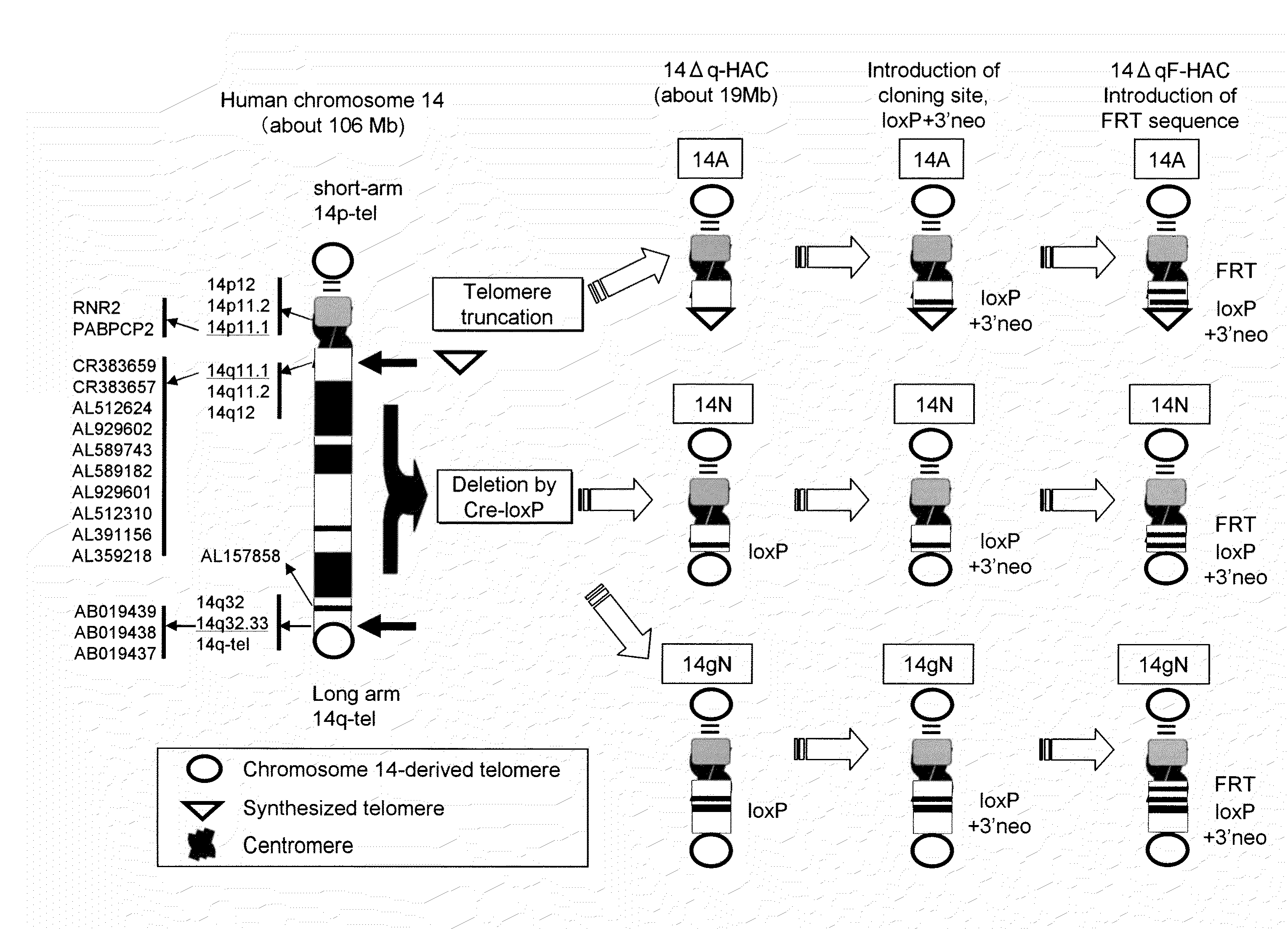Human artificial chromosome (HAC) vector and human cell medicine comprising same
a human chromosome and artificial chromosome technology, applied in the field of human artificial chromosome (hac) vectors, can solve the problems of insulator not regulating the telomere sequence, chromosome genes being disrupted, transient expression of introduced genes, etc., to enhance the efficiency of inheritance, enhance the expression level of foreign genes or foreign dna, and positively affect the stability of vector maintenance
- Summary
- Abstract
- Description
- Claims
- Application Information
AI Technical Summary
Benefits of technology
Problems solved by technology
Method used
Image
Examples
example 1
Preparation of Telomere-Type 14HAC (14ΔΔqHAC) Vector by Deletion of the Long-Arm Distal Region of Human Chromosome 14
(1) Deletion of the Long Arm of Human Chromosome 14 by Telomere Truncation
[0404](1-1) Construction of pTELpuro-t1 Vector for Telomere Truncation
[0405]As a telomere truncation vector (a targeting vector) for deleting the long-arm distal region of human chromosome 14,pTELpuro (Kuroiwa et al., Nature Biotech., U.S.A., vol. 18, pp. 1086-1090, 2000) was used. Based on the nucleotide sequence (Accession No. AL391156) of the long-arm distal region of human chromosome 14 obtained from the GenBank database, a target sequence for inserting a telomere truncation vector was designed. Sequences of oligonucleotide primers comprising restriction enzyme recognition sequences added for amplifying the target sequence by PCR are shown below.
7791F Nhe1:5′-AGCTAGCTCAACTGGCTCCTGATTTCTCTC(SEQ ID NO: 1)10680R (XhoI):5′-ATCTTCCTCGAGTCACCAAACTTG(SEQ ID NO: 2)10657F (XhoI):5′-CAAGTTTGGTGACTCGA...
example 2
Analysis of Long-Term Stability of 14ΔΔqHAC Vector in CHO Cell
(1) Long-Term Subculture Under Non-Selective Culture Conditions
[0433]In order to confirm stability of the 14ΔΔqHAC vector in CHO cells, long-term subculture was carried out under non-selective culture conditions. Three of the CHO cell lines described in Example 1 (12t97S38-6, -8, and -9; hereafter 12t7S is abbreviated to “t7S38-6, -8, and -9”) were used. The non-selection medium was F12 medium containing 10% FBS, and the selection medium contained said F12 medium and blasticidin added at 8 μg / ml. The 5.0×105 CHO cells were plated in a 10-cm dish, the cells that had been cultured to a cell density of about 80 to 90% confluency were counted, the 5.0×105 cells were plated again in a 10-cm dish, and subculture was continued up to the tenth passage. The number of cells was counted every passage to determine the population doubling level. The CHO strains were recovered after the tenth passage and FISH chromosome samples were pr...
example 3
Analysis of hEPO Gene Expression in CHO Hybrid cell Comprising hEPO-14ΔΔqHAC Vector Introduced therein
[0438](1) Construction of hEPO-14ΔΔqHAC Vector
(1-1) Introduction of hEPO Gene into 14ΔΔqHAC Vector
[0439]The hEPO gene expression unit is inserted into the 14ΔΔqHAC vector constructed in Example 1. Specifically, the hEPO expression plasmid containing the loxP sequence was prepared, and the Cre recombinase was expressed transiently to insert the gene expression unit into an artificial chromosome by site-directed recombination between the loxP sequences. A recombinant comprising an insert was selected using the acquisition of G418 resistance (i.e., reconstruction of the promoter-fragmented neo-resistant gene expression unit) as an indicator. The outline is shown in FIG. 14.
[0440]The CHO hybrid cells carrying the 14ΔΔqHAC vectors (t7S1-1, t7S38-6, and t7S38-8) prepared in Example 1 were treated with trypsin, and 5×106 cells were suspended in 0.8 ml of the Hank's balanced salt solution (...
PUM
| Property | Measurement | Unit |
|---|---|---|
| Digital information | aaaaa | aaaaa |
| Digital information | aaaaa | aaaaa |
| Digital information | aaaaa | aaaaa |
Abstract
Description
Claims
Application Information
 Login to View More
Login to View More - R&D
- Intellectual Property
- Life Sciences
- Materials
- Tech Scout
- Unparalleled Data Quality
- Higher Quality Content
- 60% Fewer Hallucinations
Browse by: Latest US Patents, China's latest patents, Technical Efficacy Thesaurus, Application Domain, Technology Topic, Popular Technical Reports.
© 2025 PatSnap. All rights reserved.Legal|Privacy policy|Modern Slavery Act Transparency Statement|Sitemap|About US| Contact US: help@patsnap.com



